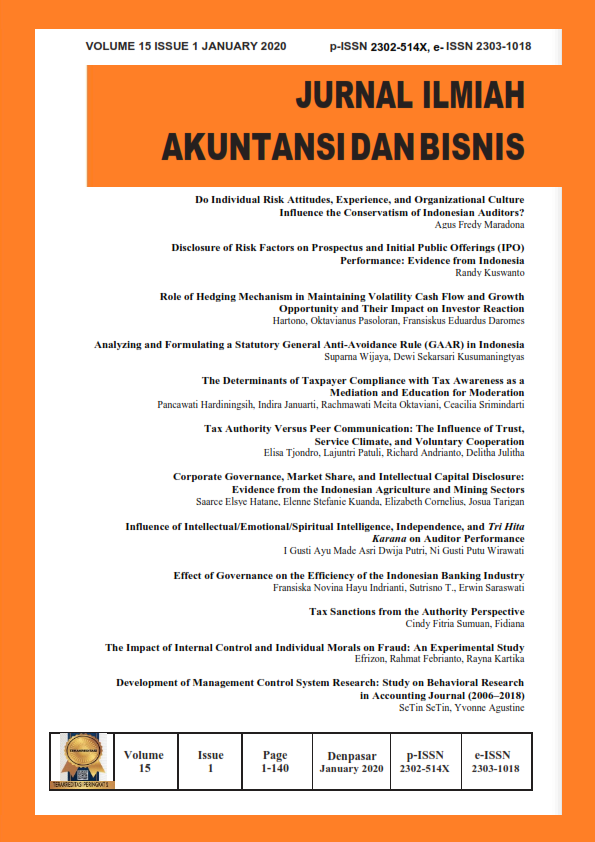Analyzing and Formulating a Statutory General Anti-Avoidance Rule (GAAR) in Indonesia
Abstract
Dealing with the practice of tax avoidance in general, many countries have compiled and implemented their own general anti-avoidance rules (GAAR). This research aims to explore the potential of statutory GAAR in handling tax avoidance practices in Indonesia and SAAR formulas that are suitable for the Indonesian context. This qualitative research employed a case study approach. Results show that the application of SAAR and the principle of substance over form in Indonesia cannot yet be applied properly; thus GAAR is needed. It is expected that the implementation of statutory GAAR can accommodate the limitations of regulators in light of unknown and future tax avoidance schemes..
Keywords: Tax-avoidance, tax planning, specific anti avoidance rule (SAAR), international tax
Downloads
References
Ariyanti, F. (2016). Perusahaan Asing Gelapkan Pajak Selama 10 Tahun. Retrieved December 18, 2019, from Liputan6.com website: https://www.liputan6.com/bisnis/read/2469089/2000-perusahaan-asing-gelapkan-pajak-selama-10-tahun?utm_expid=.9Z4i5ypGQeGiS7w9arwTvQ.0&utm_referrer=https%3A%2F%2Fwww.google.co.id%2F
Arnold, B. (2008). A comparison of statutory general anti-avoidance rules and judicial general anti-avoidance doctrines as a means of controlling tax avoidance: Which is better? (What would John Tiley think?). In J. Avery Jones, P. Harris, & D. Oliver (Eds.), Comparative Perspectives on Revenue Law (pp. 1–24).
https://doi.org/10.1017/CBO9780511585951.003
Arnold, B. J. (2017). The Role of a General Anti-Avoidance Rule in Protecting the Tax Base of General Anti-Avoidance Rule Is a GAAR Necessary ? Is a GAAR Necessary ? Major Features of a GAAR. In A. Trepelkov, H.
Tonino, & D. Halka (Eds.), United Nations Handbook on Selected Issues in Protecting the Tax Base of Developing Countries – Second Edition (2nd ed., pp. 715–754). New York: United Nations.
Ault, H. J., & Arnold, B. J. (2017). Protecting the Tax Base of Developing Countries: An Overview. In A. Trepelkov, H.
Tonino, & D. Halka (Eds.), United Nations Handbook on Selected Issues in Protecting the Tax Base of Developing Countries – Second Edition (2nd ed., pp. 1–33). Retrieved from http://www.un.org/esa/ffd/wp-
content/uploads/2017/08/handbook-tax-base-second-edition.pdf
Besley, T., & Persson, T. (2014). Why do developing countries tax so little? Journal of Economic Perspectives, 28(4), 99–120. https://doi.org/10.1257/jep.28.4.99
Cooper, G. (2001). International Experience with General Anti-Avoidance Rules. SMU Law Review, 54(1), 83–130.
Creswell, J. W. (2013). Qualitative, Quantitative, and Mixed Methods Approaches: 4th edition. In Organizational Research Methods (Vol. 6). https://doi.org/10.1007/s13398-014-0173-7.2
Darussalam. (2017). Ini Beda Tax Planning, Tax Avoidance, dan Tax Evasion. Retrieved December 18, 2019, from news.ddtc.co.id website: https://news.ddtc.co.id/perencanaan-pajak-ini-beda-tax-planning-tax-avoidance-dan-tax-evasion-9750
Deny, S. (2016). Dirjen Pajak Diminta Usut Dugaan 2.000 PMA Mangkir Bayar Pajak - Bisnis Liputan6.com. Retrieved December 18, 2019, from liputan6.com website: https://www.liputan6.com/bisnis/read/2471851/dirjen-pajak-diminta-usut-dugaan-2000-pma-mangkir-bayar-pajak
Ernst & Young. (2013). GAAR rising: Mapping tax enforcement’s evolution. Ernst & Young.
Freedman, J. (2014). Designing a general anti-abuse rule: striking a balance. Asia-Pacific Tax Bulletin, 20(3), 167–173.
Freedman, J. (2016). General Anti-Avoidance Rules (GAARs) A Key Element of Tax Systems in the Post-BEPS Tax World? The UK GAAR. In GAARs - A Key Element of Tax Systems in the Post-BEPS World (pp. 1–24). https://doi.org/10.2139/ssrn.2769554
International Monetary Fund. (2018a). Indonesia: 2017 Article IV Consultation-Press Release; Staff Report; and Statement by the Executive Director for Indonesia. In IMF Staff Country Reports (Vol. 18). https://doi.org/10.5089/9781484340622.002
International Monetary Fund. (2018b). Indonesia: Selected Issues; Country Report No. 18/33; December 21, 2017 (Vol. 18). Washington D.C.
James, S., Nobes, C., & Economie, B. (1978). Economics of taxation (1st ed., Vol. 1). Oxford: Philip Allan.
Krever, R. E. (2016). General Report, GAARs – A Key Element of Tax Systems in the Post-BEPS World. In M. Lang, J. Owens, P. Pistone, A. Rust, J. Schuch, & C. Staringer (Eds.), GAARs – A Key Element of Tax Systems in the Post-BEPS World (pp. 1–20). Amsterdam: IBFD Publications.
Office, A. T. PS LA 2005/24 - Application of General Anti-Avoidance Rules. , Pub. L. No. PS LA 2005/24 (2016).
Prasetyo, K. A. (2013). Penggelap Pajak, Awas!! InsideTax Media Tren Perpajakan (Di Balik Suap Pajak), 15, 62–65.
Richard Krever, & Mellor, P. (2016). Australia: General Anti-Avoidance Rules (GAARs) – A Key Element of Tax Systems in the Post-BEPS World. In M. Lang, J. Owens, P. Pistone, A. Rust, J. Schuch, & C. Staringer (Eds.), GAARs – A Key Element of Tax Systems in the Post-BEPS World (pp. 45–64). Retrieved from https://www.researchgate.net/publication/304749913_Australia_General_Anti-Avoidance_Rules_GAARs_-_A_Key_Element_of_Tax_Systems_in_the_Post-BEPS_World
Silvani, C. (2013). GAARs in Developing Countries (1st ed.). Retrieved from https://books.google.co.id/books/about/GAARs_in_Developing_Countries.html?id=iMpiswEACAAJ&redir_esc=y
Simanjutak, T. H., & Mukhlis, I. (2012). Dimensi Ekonomi Perpajakan dalam Pembangunan Ekonomi (1st ed.). Depok: Raih Asa Sukses.
Sugiyono. (2012). Metode Penelitian Kuantitatif, Kualitatif, dan R&D (4th ed.). Bandung: Alfabeta.
Suryani, N. E., & Devos, K. (2016). The Proposed Design of an Indonesian General Anti-Avoidance Rule. World Applied Sciences Journal, 34(12), 1783–1789. https://doi.org/10.5829/idosi.wasj.2016.1783.1789
Tretola, J. (2017). Comparing the New Zealand and Australian GAAR. Revenue Law Journal, 25(1), 1–27. https://doi.org/10.2139/ssrn.3106522
Triyanto, H. U., & Zulvina, S. (2017). Analisis Perumusan Kebijakan Mandatory Disclosure Rules Sebagai Alternatif Dalam Mengatasi Praktik Penghindaran Pajak Di Indonesia. Jurnal Pajak Indonesia, 1(1), 1–10.
Waerzeggers, C., & Hillier, C. (2016, January). Introducing A General Anti-Avoidance Rule (GAAR). Tax Law IMF Technical Note, 1(01), 1–10.
Wijaya, I. (2014). Mengenal Penghindaran Pajak. Retrieved December 18, 2019, from https://www.linkedin.com/pulse/20140726022710-57653111-mengenal-penghindaran-pajak-tax-avoidance




















